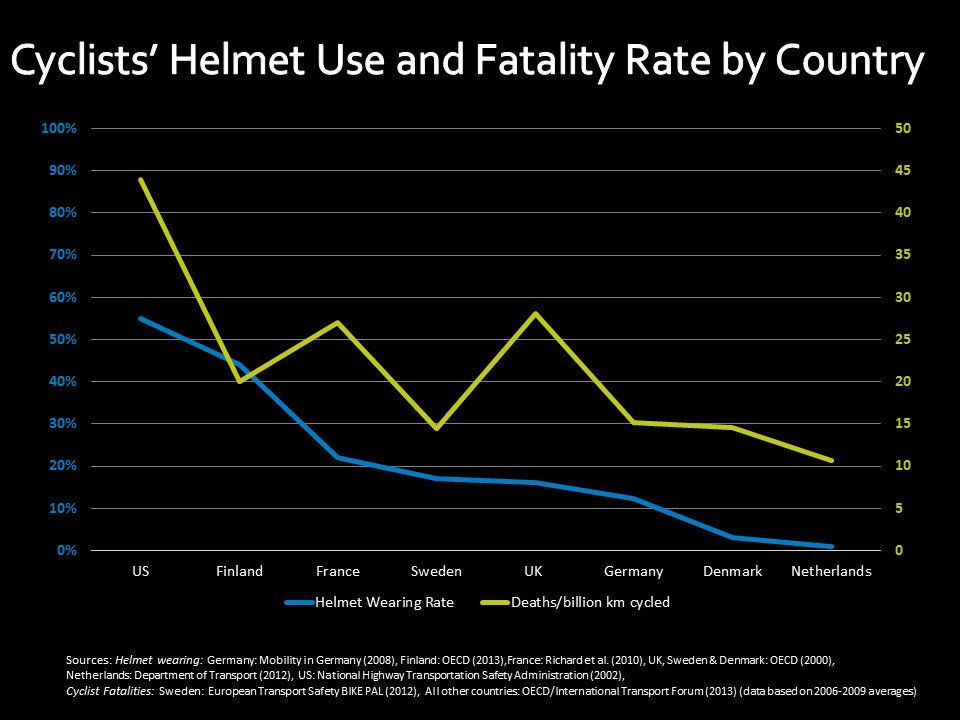I ride a bike every day. I don’t support wearing a helmet for everyday bicycling. GOOD GOD WHY NOT, you ask:
Helmets are protective…but you know what’s more protective?
Protected bike lanes. Helmets help, but not nearly enough–and studies show the cars drive closer to cyclists with helmets on.
“Meanwhile, it seems that bicyclists wearing helmets may encourage riskier driving by motorists. Traffic psychologist Ian Walker from the University of Bath equipped a bike with a sensor to record the distance between him and passing vehicles. He took more than 2,300 measurements and found that motorists passed him more closely when he wore a helmet. (He was also struck twice, by a bus and a truck, during the study — both times while wearing a helmet.).” Read the rest of this article, here.
What if I told you that study after study shows that bike helmets are not key to making cycling safer?
You know where no one wears helmets? Amsterdam, Copenhagen, Utrecht…what makes folks feel safe cycling, including children and families, is more folks on the road. And helmets often discourage folks from cycling, and lack of bike lanes even more.
“The evidence paradoxically seems to show that while wearing helmets does make cyclists safer, helmet laws don’t make cyclists safer and actually harm public health in the long run…” Read the rest here.
Really? Head injuries in cars? Very common.
Yet no one advocates for helmets on car drivers.
You know what we should advocate for? Protected, separate bike lanes.
And texting and driving, and other forms of distracted driving should be made illegal with severe penalty.
The stat comes at 3:47:
A few months ago, I was hit by a car. I wore a helmet for a few weeks, after, then started forgetting (as I rolled down the Hill upon which I live, inevitably about a minute into the ride I’d intone a silent dammit!)…then just gave up. It messes up your hair. It spoils that feeling of the wind and open sky, the convertible-top-down feeling that is bike riding. It’s hot, stuffy, it makes little noises around your ears, the very ears upon which I’m dependent to hear cars sneaking up behind me. It’s ugly, turning me from Waylon into a Legoman.
Here’s a few more serious reasons.
> If you support folks wearing bike helmets, you should first support there being a law that bike lanes or bike paths are accessible everywhere. They make things far safer than bike helmets—see Amsterdam, or any country where tons of folks cycle without helmets, but with traffic signs and bike lanes and bike paths.
Stats show that head injuries while driving a car are frequent and serious, but no one advocates helmets for car/truck drivers.There’s only one solution for truly safe cycling: treat cyclists like a valid form of transportation—pedestrians get sidewalks, car drivers get roads–cyclists get protected bike lanes.Cost-wise, every cyclist you get out of a car saves taxpayer dollars spent on road maintenance, pollution, accidents.
Oh, and it can and will save my life—if I wear it. So how do you all get yourself to wear a helmet? Or do you not bother? Should it be made a federal law, as it is in parts of the country, and in Canada where I visit me mum?
~
”Over the past several decades, society has come to equate safety with helmets,” said Charles Komanoff, the co-founder of Right of Way, an organization that promotes the rights of cyclists and pedestrians. ”But wearing a helmet does not prevent crashes.”
Vox agrees:“Chris Bruntlett: We — like you — live in a place where helmets have been mandated by law, because they’ve been accepted as a commonsense safety device, normal as a seatbelt. But the Dutch show that [for them], safety in infrastructure, safety in slowing cars, and safety in numbers are all far more important than safety in body armor…
David Roberts: Yeah, the US approach seems to be to up-armor the cyclist so that cars don’t have to change.”
Mr. Speaker, do you support requiring city bike riders to wear helmets for safety.
CJ: No. Absolutely not.
SR: (incredulously) Why not?
CJ: Because if you require helmets, you’ll have much, much fewer people riding bikes across New York City. It is a barrier. It has not worked in other cities around the world. It has not worked in the United States of America. On face value, you might think it’s the right thing to do, but if you did that, you would have a fraction of the people biking in New York City. We want to encourage cycling in New York City, not make it more difficult. There have been studies about this, in the United States and around the world. It has been counter-productive, not helpful, not made it safer, so we are not going to go in that direction. It sounds like an easy sound bite to say, “Let’s make cyclists do that,” but if you look at the research and the facts and the studies, it’s not the right thing to do.
SR: But we are talking about safety. Isn’t it almost a no-brainer if helmets can help keep cyclists safer.
CJ: If you look at the studies, they’ll show you that it’s not a no-brainer. That actually, if you require helmets, it becomes less safe on the streets of the city because you’d have less people who cycle, which means that [drivers] don’t have to think about cyclists. It’s counter-intuitive in some ways, but that is what the science shows on this. Most people who are killed by cars and trucks, a helmet wouldn’t even help them because of the sheer scope of the accident.
SR: Not to be truculent, if a cyclist gets hit, falls and lands on his head, isn’t it logical that a helmet is going to help him?
CJ: We want people to wear helmets. But requiring them to wear helmets is a totally different thing. Go look at what other cities across the United States have found out when they tried that. It hasn’t work. It’s made it less safe for cycling in those cities.

“…Little wonder that advocacy groups in the U.S. focus so much energy on improving cycling infrastructure. While helmets can help mitigate specific head injuries when a crash happens, organizations such as People for Bikes want to find ways to prevent those crashes—especially collisions between cars and bikes—from happening at all.
A 2015 report by the National Highway Traffic Safety Administration found that 70 percent of cyclist deaths occurred in urban areas. Only 3 percent of those fatalities took place in a bike lane. If you really want to make your road rides safer, joining your local advocacy group, or organizing one to push your city and state for better bike networks, is a great place to start. Simply donning a helmet is no substitute for safer streets…”
~
Read more here:
“…in places where helmet requirements have driven cyclists off the road it has been argued that the negative effects on public health outweigh any possible benefits in prevented injuries. In Australia, when a helmet law was introduced at a time when the popularity of cycling was on the rise, a 44% decrease in children cycling was observed, which was five times the size of the increase in children wearing helmets. According to a paper published in the BMJ, it would take “at least 8000 years of average cycling to produce one clinically severe head injury and 22,000 years for one death“. It has also been estimated that the health benefits of cycling outweigh the life-years lost by a factor of twenty to one.”



Read 33 comments and reply